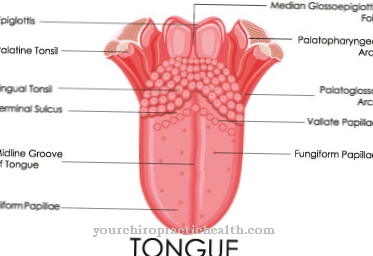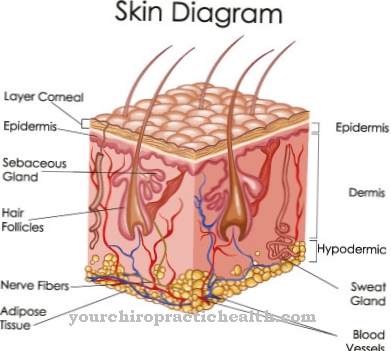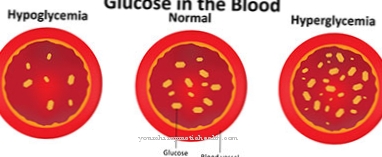The Rotator cuff rupture or the Rotator cuff tear is an injury in the shoulder area that usually requires treatment. Prevention is only possible to a limited extent, but early therapy can often restore full functionality.
What is a rotator cuff tear?
.jpg)
© bilderzwerg - stock.adobe.com
At a Rotator cuff rupture it is a tear in the so-called rotator cuff. This rotator cuff is located in the shoulder and is partly responsible for stabilizing the shoulder joint.
A rotator cuff tear can affect four different muscles with associated tendons that make up the rotator cuff; for example the upper or lower bone muscle or the lower shoulder blade muscle. The symptoms associated with a rotator cuff tear depend, among other things, on the extent of the tear; however, it is not uncommon for smaller tears to lead to greater pain than more severe tears.
Characteristic signs of a rotator cuff rupture are primarily shoulder pain, which varies depending on the various loads and positions of the rotator cuff. Typically, a rotator cuff rupture causes pain when lifting the arm sideways. Men who have already reached the age of 30 are mainly affected by a rotator cuff rupture.
causes
One Rotator cuff rupture can have various causes. In most cases, the rotator cuff only ruptures if the tendons have already been damaged. One possible cause of a rotator cuff rupture is, for example, what is known as degeneration, i.e. wear of the rotator cuff.
Such wear and tear can be promoted, for example, by long-term professional activities that include a lot of overhead work or through so-called overhead sports; These sports include golf and tennis, for example.
Another cause of a rotator cuff rupture can be an impairment of the tendons, which is caused by a lack of space for the corresponding tendons in the shoulder area. And finally, accidents can also lead to a rotator cuff rupture, which can lead to falls on the shoulder or arm.
Symptoms, ailments & signs
The rotator cuff rupture is characterized by the appearance of various symptoms. This is mainly pain in the shoulder. These may appear suddenly or develop gradually depending on the extent of the tear. Most of the time the pain depends on the position or the load.
They also often occur at night when the patient is lying on the affected side of the body. When the affected arm is lifted to the side against resistance, pain in the upper arm or shoulders usually also occurs. It hurts particularly badly when the angle of separation is between 60 and 120 degrees.
In the case of smaller tears, the rotator cuff tear can even remain symptom-free. However, it also happens here that the pain slowly develops and intensifies over a period of about two days. Elderly people often experience very slowly increasing pain over a long period of time. This can make it difficult for them to diagnose the disease. Overall, the symptoms lead to a decrease in arm strength.
As a result, those affected can no longer perform certain activities. The symptoms depend, among other things, on whether the tear occurred before or after a tendonitis, the cuff was partially or completely torn, and the period in which the changes developed. In severe cases, the pain also occurs at rest.
Diagnosis & course
_2.jpg)
To a suspected diagnosis Rotator cuff rupture it can initially occur on the basis of typical painful complaints on the shoulder; A characteristic weakening of the muscles associated with a rotator cuff tear can also substantiate a suspected diagnosis.
Both muscle weakness and impairment of movement sequences can be determined more precisely by a diagnostician during a physical examination using various tests. If necessary, so-called imaging methods can be used for a detailed diagnosis in a further step; These include, for example, X-ray or ultrasound examinations.
In principle, the course of a rotator cuff tear depends, among other things, on the severity of the tear. However, if a rotator cuff tear is detected early and, if necessary, medically treated, full functionality can be regained in most cases.
Complications
Depending on how severe the rotator cuff tear is, various complications are possible. This risk is particularly high if the crack is not properly treated. One of the conceivable consequences of a rotator cuff tear is joint wear (omarthrosis) of the shoulder.
In medicine, this form of osteoarthritis is also known as defect arthropathy. Another possible effect is the so-called frozen shoulder. This shows movement restrictions of the shoulder joint that cannot be reversed even with the help of treatment. If the rotator cuff tear is due to wear and tear, which is the case in most patients, the affected tendons can tear repeatedly at a later point in time.
The greater the extent of the previous damage, the more likely a new crack is. In the case of severe impairments, the frequency of repeated ruptures is around 70 percent. After considering the severity, on average every fourth patient will have a new rotator cuff rupture in the course of their life.
If the rotator cuff tear is treated surgically, there is also a risk of complications. These primarily include wound healing disorders, infections, restricted mobility, another rotator cuff tear and a permanent deficit of strength. In addition, residual symptoms may remain. If the nerves are injured, there is a risk of paralysis or sensitivity disorders.
It can take four to six months for the patient to feel no more discomfort after the operation. Activities that put pressure on the shoulder may only be carried out again after three to four months in order to avoid negative effects.
When should you go to the doctor?
A rotator cuff tear should always be evaluated and treated by a doctor. As a rule, self-healing cannot occur with this disease, so that the patient is always dependent on medical treatment. This can prevent further complications. If the rotator cuff ruptures, a doctor should be consulted if the person is suffering from severe pain in the shoulder.
It is not uncommon for this pain to spread to other regions of the body, where it can lead to discomfort. This pain can also occur at night and disturb the sleep of the person concerned. In most cases, the pain occurs when the person concerned turns or bends their shoulder sharply. Furthermore, a decrease in arm strength may indicate a rotator cuff tear and should be investigated.
Primarily, the rotator cuff rupture can be examined by a general practitioner. In some cases, surgical intervention is necessary for further treatment.
Treatment & Therapy
Usually one does Rotator cuff rupture medical treatment is necessary. A targeted therapy of the rotator cuff rupture is based on various factors: The severity of the rotator cuff rupture plays an important role; For example, there may be a complete tear, but also just a tear in one or more tendons.
Furthermore, an adapted therapy depends on the severity of the pain, the age of the patient and the degree of resilience of the rotator cuff. As part of a subsequent therapy, the strength and functionality of the affected shoulder should be restored and freedom from pain should be achieved.
Treatment of a rotator cuff rupture can be either surgically or conservatively (without the use of surgical measures). Surgical treatment of the rotator cuff rupture is often possible with the help of a so-called arthroscopy (a joint reflection); this method, which is also known as keyhole surgery, makes a so-called open operation with a large skin incision unnecessary.
Possible components of a conservative treatment of the rotator cuff rupture are, for example, anti-inflammatory and pain-relieving drugs or injections as well as physiotherapeutic (physiotherapy) measures.
You can find your medication here
➔ Medicines for painprevention
One Rotator cuff rupture prevention is only possible to a limited extent. If the tendons have previously been damaged, long-term overhead activities pose a risk of developing a rotator cuff rupture. For example, for amateur athletes who have already suffered a rotator cuff rupture, it can make sense to do sports in which the arms and shoulders are only stressed to a limited extent. Professions that require frequent overhead work are, for example, those of painters and varnishers.
Aftercare
Follow-up care is particularly necessary in the case of surgical treatment of the rotator cuff tear. After the procedure, the rotator cuff needs enough rest to heal.As a rule, it takes six to eight weeks until you are able to exercise. A special pillow is placed on the patient to protect himself. He has to wear this consistently for a period of four to six weeks.
He should only remove the pillow to put it on or to clean the body. In addition, he is not allowed to move the treated arm in the side or in the front direction. This creates the risk of a new rotator cuff tear. The arm being treated can also be immobilized using a sling (orthosis).
The shoulder is mobilized passively and takes place as part of physiotherapy. This means that the patient is not allowed to move his arm himself. The movements are carried out exclusively by the therapist. The passive mobilization is followed later by the active mobilization.
The shoulder can be moved independently again. Strengthening the muscles also plays an important role. However, the shoulder should not be heavily stressed for about ten to twelve weeks. The physiotherapeutic follow-up treatment can restore the functionality of the shoulder for everyday life, which can take up to six months.
You can do that yourself
This painful condition belongs in the hands of a doctor. The family doctor will decide whether conservative or surgical treatment is necessary in the present case. The rupture will not heal on its own, and a rotator cuff rupture usually leads to further ruptures.
This is the reason why from now on sports such as climbing, golf or tennis are no longer allowed to be practiced. Even if, after successful treatment, the patient is able to raise his arm over his head without pain, this provokes a new rupture. This also applies to people with professions that require overhead work, such as painters and varnishers. It is recommended to retrain here.
A rotator cuff rupture can lead to joint wear and thus to omarthrosis, i.e. a certain form of osteoarthritis. To prevent this, patients are advised to take their pain relievers, such as ibuprofen, regularly, as they not only reduce pain but also reduce inflammation.
Alternative medicine also recommends various dietary supplements and phytotherapeutic agents that are said to have anti-inflammatory properties. These include certain enzymes such as bromelain, but also glucosamine, chondroitin, claw thorn (Cat’s Claw), Boswellia Serrata (incense) and the sulfur compound methylsulfonylmethane, MSM for short. Doctors with a naturopathic background or correspondingly specialized naturopaths provide more information on their intake and effectiveness.

.jpg)



.jpg)





















